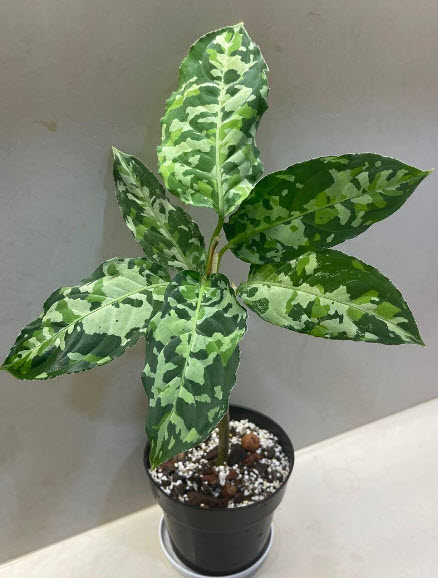Story of Day :
The Aglaonema Pictum Tricolor is a variegated leafed plant that is renowned for its attractive, variegated leaves. The leaves of this plant are green with white and pink stripes.
It is a Southeast Asian native that is frequently grown as a houseplant in other parts of the world.
These plants are simple to care for and are a wonderful addition to any home.

This plant is a member of the Araceae (Arum) family. It has large, rounded leaves that have camouflage patterns.
The Aglaonema Pictum Tricolor generally grows to 1-2 feet tall. It is a nice, tropical plant that can be a wonderful addition to any house, but like all plants, it has to be cared for properly.
Also, read about what is Chinese evergreen and how to grow.
Contents
Propagate Aglaonema Pictum Tricolor
Stem cuttings of Aglaonema Pictum Tricolor can be propagated. Make a 4 to 6-inch section of stem below a leaf node using a sharp knife or pair of scissors.
Put the cutting in a minimum 4-inch pot with a well-draining potting soil that covers the leaf node. Water the cutting well and place it in a bright, indirect light setting.
The cutting will develop roots and new growth in 6-8 weeks if the soil is kept moist but not wet.
Also, read about 23 different types of aglaonema varieties.
Sunlight / Location
The Aglaonema Pictum Tricolor prefers bright, indirect lighting, but it can tolerate dim lighting conditions. Avoid direct sunlight, as it will burn the leaves.
If the lights are too dim, the leaves will become pale and the plant will become sparse. North- or east-facing windows can be used to house Aglaonema Pictum Tricolor.
Soil
The soil should be well-draining potting soil. Peat moss, vermiculite, and perlite are all good materials for this plant.
A 50:25:25 split of peat moss, perlite, and vermiculite is the ideal composition for this plant.
The plant will be nourished if the soil is moistened and supplied with nutrients on a regular basis.
Water
The Aglaonema Pictum Tricolor should be watered so that the soil is evenly moistened. It is critical that the soil is neither too wet nor too dry, as this may injure the plant.
Allow the top inch or so of soil to dry before watering again.
Check the moisture level by poking your finger into the ground.
Temperature
The best temperature range is between 70 and 85 degrees Fahrenheit. This plant does not do well in cold temperatures, so keep it in a warm environment.
If the temperature drops below 60 degrees Fahrenheit, the plant’s leaves will begin to drop off.
Humidity
60-70% humidity is ideal for Aglaonema Pictum Tricolor.
The plant is not tolerant of low humidity, so you may need to use a humidifier if the air in your home is particularly dry.
You may also want to mist your plant frequently to increase the humidity.
Fertilizer
The right fertilizer is important to its care. Aglaonema Pictum Tricolor needs the right fertilizer. To choose the right fertilizer for this plant, keep the following in mind.
Aglaonema Pictum Tricolor does best with a high-nitrogen fertilizer. This will promote healthy growth. Follow the directions on the package when applying the fertilizer.
It’s critical to use the correct amount. Apply a balanced liquid fertilizer diluted to 1/4 strength every two months. When in doubt, err on the side of putting on too little rather than too much fertilizer.
On occasion, you may also add a small spoon of Epsom salt.
Adding it to the growing medium twice or three times a year will boost nutrient absorption and result in deeper colors.
With a little care, your aglaonema Pictum Tricolor will thrive and provide you with a lot of pleasure.
Diseases and Pests
Pests can also cause aglaonema Pictum Tricolor problems. Mealybugs, spider mites, and scale are common pests.
These little white creatures suck sap from plants and are mealybugs. Spider mites suck sap from plants and can be controlled with a miticide.
Scale is small, hard-bodied creatures that suck sap from plants. They can be controlled with an insecticide or manually removed from the plant by removing them.
Pet Protection
Calcium oxalate crystals, which are toxic to cats and dogs, are present in Araceae family plants because of the insolubility of calcium oxalates.
Temporary symptoms such as tongue swelling, drooling, vomiting, and loss of appetite may result if cats or dogs consume it.
